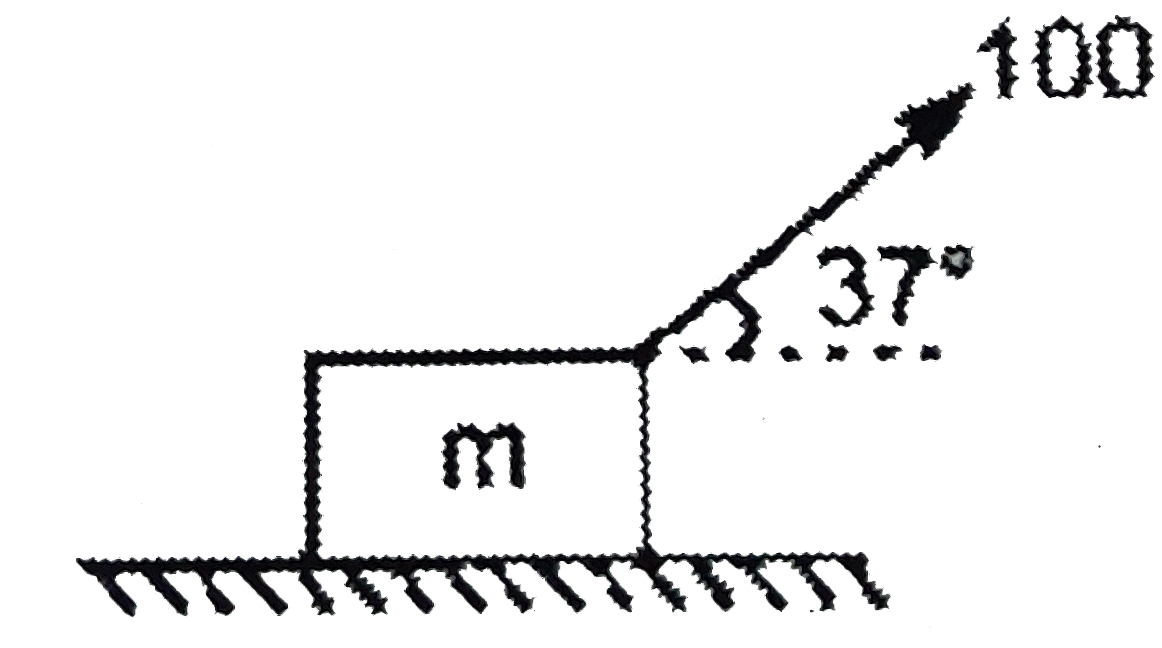A block of mass 5 kg and volume 0.05m3 floats in a liquid of density 140kg m−3 .
Fraction of block outside liquid is
27
72
37
73
The correct Answer is:A
To find the fraction of the block that is outside the liquid, we can follow these steps:
Step 1: Write down the given data
- Mass of the block, m=5kg
- Volume of the block, V=0.05m3
- Density of the liquid, ρ=140kg/m3
Step 2: Calculate the volume of the block submerged in the liquid
Using the principle of buoyancy, the weight of the block is equal to the weight of the liquid displaced by the submerged part of the block.
The weight of the block is given by:
W=m⋅g
Where g is the acceleration due to gravity. Since g will cancel out later, we can ignore it for now.
The weight of the displaced liquid can be expressed as:
Wdisplaced=Vi⋅ρ⋅g
Where Vi is the volume of the block submerged in the liquid.
Setting these two weights equal gives us:
m=Vi⋅ρ
Thus, we can find the volume submerged:
Vi=mρ
Substituting the values:
Vi=5kg140kg/m3=5140=128m3
Step 3: Calculate the volume of the block outside the liquid
The volume of the block outside the liquid, V0, can be calculated as:
V0=V−Vi
Substituting the values:
V0=0.05m3−128m3
To perform this subtraction, we need a common denominator. The volume 0.05m3 can be expressed as:
0.05=5100=120
Finding a common denominator (which is 140):
120=7140and128=5140
Now, substituting these values:
V0=7140−5140=2140=170m3
Step 4: Calculate the fraction of the block outside the liquid
The fraction f of the block outside the liquid is given by:
f=V0V
Substituting the values:
f=1700.05
Expressing 0.05 as 5100=120:
f=170×201=2070=27
Final Answer
The fraction of the block outside the liquid is:
27
---
- Mass of the block, m=5kg
- Volume of the block, V=0.05m3
- Density of the liquid, ρ=140kg/m3
Using the principle of buoyancy, the weight of the block is equal to the weight of the liquid displaced by the submerged part of the block.
W=m⋅g
Where g is the acceleration due to gravity. Since g will cancel out later, we can ignore it for now.
Wdisplaced=Vi⋅ρ⋅g
Where Vi is the volume of the block submerged in the liquid.
m=Vi⋅ρ
Thus, we can find the volume submerged:
Vi=mρ
Substituting the values:
Vi=5kg140kg/m3=5140=128m3
The volume of the block outside the liquid, V0, can be calculated as:
V0=V−Vi
Substituting the values:
V0=0.05m3−128m3
0.05=5100=120
Finding a common denominator (which is 140):
120=7140and128=5140
Now, substituting these values:
V0=7140−5140=2140=170m3
The fraction f of the block outside the liquid is given by:
f=V0V
Substituting the values:
f=1700.05
Expressing 0.05 as 5100=120:
f=170×201=2070=27
The fraction of the block outside the liquid is:
27
Topper's Solved these Questions
- THRUST AND PRESSUREBook:MTG IIT JEE FOUNDATIONChapter:THRUST AND PRESSUREExercise:Exercise (Subjective problem (Very short answer type) )
Explore 15 Videos
- THRUST AND PRESSUREBook:MTG IIT JEE FOUNDATIONChapter:THRUST AND PRESSUREExercise:Exercise (Subjective problem (Short answer type) )
Explore 15 Videos
- THRUST AND PRESSUREBook:MTG IIT JEE FOUNDATIONChapter:THRUST AND PRESSUREExercise:Exercise (Assertion & Reason type)
Explore 10 Videos
- SOUNDBook:MTG IIT JEE FOUNDATIONChapter:SOUNDExercise:Olympiad/HOTS Corner
Explore 15 Videos
- WORK AND ENERGYBook:MTG IIT JEE FOUNDATIONChapter:WORK AND ENERGYExercise:Olympaid/HOTS Corner
Explore 20 Videos
Similar Questions
A body of mass 2.0 kg and density 8000 kgm3 is completely dipped in a liquid of density 800 kgm3. Find the force of buoyancy on it.
View SolutionIn Fig. , a rectangular block floats in a liquid . A block of mass m = 0.500 kg and density ρ=700kg/m3 floats face down in a liquid of density ρf=1200kg/m3 . What are the magnitude of the buoyant force on the block from the liquid , the weight of the liquid displaced by the block (liquid that would be in the space now occupied by the block ) , and the mass of that displaced liquid ? What fraction of the block's volume is submerged ? What fraction of its height is submerged ?

View Solution
Knowledge Check
A block of mass 5 kg and volume 0.05m3 floats in a liquid of density 140kg m−3 .
The fraction of block inside liquid isA75B27C57D72A block of mass 5 kg and volume 0.05m3 floats in a liquid of density 140kg m−3 .
Volume of block above the surface of liquid isA0.024m3B0.014m3C0.015m3D0.041m3A cylindrical of wood (density =600kgm−3) of base area 30cm2 and height 54cm, floats in a liquid of density 900kg−3 The block is deapressed slightly and then released. The time period of the resulting oscillations of the block would be equal to that of a simple pendulum of length (nearly) :
A26cmB52cmC36cmD65cm
A body of mass 2.0 kg and density 8000 kgm3 is completely dipped in a liquid of density 800 kgm3. Find the force of buoyancy on it.
View Solutionm=20kg,μs=0.5, find friction on block.

View SolutionA steel ball of density 8.0×103kg/m3 and radius 2 mm is observed to fall with a terminal velocity 1.0×10−2m/s in a liquid of density 1.8×103kg/m3 . Calculate the viscosity of the liquid.
View SolutionAn iceberg of density 900kg/m3 is floating in water of density 1000kg/m3. The percentage of volume of ice cube outside the water is
View SolutionA layer of oil with density 724 kg m−3 floats on water of density 1000kgm−3. A block floats on the oil-water interface with 1/6 of its volume in oil and 5/6 of its volume in water, as shown in the figure. What is the density of the block?

View Solution
